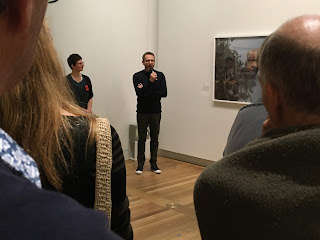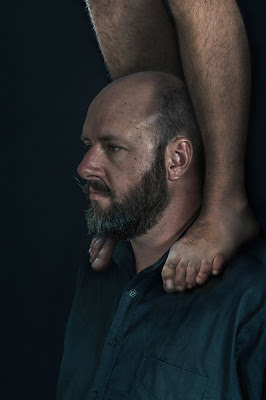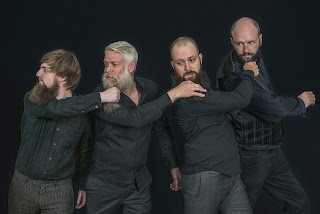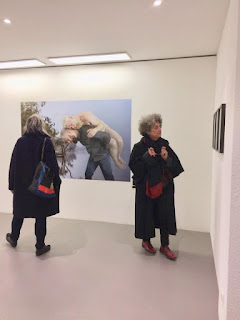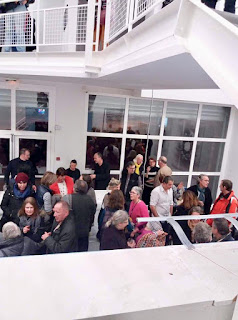Wednesday, March 24, 2021
HE SHE THEY: Gender diversity encourages inclusion at Bunbury Biennale - writer Annette Peterson
Sunday, February 28, 2021
Sunday, December 13, 2020
Tuesday, December 1, 2020
2020 BOTANIC ART PRIZE, 2 November 2020 - 1 January 2021. Gallery 125, York Western Australia
Thursday, November 5, 2020
2020 BOTANIC ART PRIZE, 2 November 2020 - 1 January 2021. Gallery 125, York Western Australia
Banksia Man, Christophe Canato’s work is inspired by the 1918 published adventures of Snugglepot and Cuddlepieby Australian author May Gibbs.
The central story arc concerns Snugglepot and Cuddlepie and their adventures along with troubles and the villains of the stories; the Banksia Men.
In the original series of books the villains "big bad" Banksia Men are modelled on the appearance of aged Banksia "cones", with follicles for eyes and other facial features. But Christophe Canato is proposing a contemporary version with his Banksia Man where the follicles became part of the man body, the leaves will be placed such as a super hero/villain mask and hairy flowers of the Banksia specimen are completing a fiction decor.
To reinforce the notion between fantasy and real, Canato uses multiple layers of photographs to deliver a final image more or less fuzzy, evanescent as in a dream. The powdery colours bring a feeling of serenity and softness to the disturbing character.
Sunday, September 27, 2020
ANIMA - Perth Centre For Photography, 26 September - 07 November 2020
ANIMA. The inner feminine side of a man.
Christophe Canato has made his name in France, Australia and Singapore as a photo-media artist. His work examines male roles and identities in our contemporary western contexts. Canato is interested about exploring social issues such as politics and religion, including physical identities and sexual orientations.What questions this artist is the notion of belonging or rejection and the status that man is supposed to hold in society.
Canato’s new work Anima is an immersive, polychromatic photographic series that is exploring the inner feminine side of the man.
The Anima is both a personal complex and an archetypalthat expresses the fact that man psychehas a minority of feminine qualities according to psychologist Carl Jung (26 July 1875 - 6 June 1961). It is an unconscious factor incarnated anew in every male child and is responsible for the mechanism of projection. The Anima versus Animus are described by Jung as part of his theory of theCollective unconscious.In every man there is a woman and in every woman a masculine side, her Animus.
On the other hand, one of the factors that the artist likes to take into account in his research is the colour of the skin. But this time Canato is interested in the extraordinary character of the imaginary skin colours such as blue, green, red or white although making references to codes recognizable by all. To name a few Krishna or Shiva as part of the Indian divinities and in another register James Cameron’s fiction Avatar.
Biography
Born in France, Christophe Canato undertook postgraduate studies in Grenoble and Paris, where he continued to live and work before moving to Perth Australia in 2005. His work has been exhibited in more than fifty solo and collective exhibitions including the National Portrait Gallery in Canberra. Multiple prize winner Christophe Canato’s photographs are also included in public collections such as Artbank Australian Federal Government collection. His series are published internationally in France, England, Australia including the Chinese magazine Photoworld with a eight page publication, March 2020.
Wednesday, August 5, 2020
SPRING, mentoring program for visual artists
With Christophe Canato
APPLY HERE: artsource.typeform.com/to/MiWYYnrH
Christophe is a French-Australian photographer and photomedia artist based in Perth since 2005, having graduated from the Beaux-Arts in France. Over the past 25 years, he has extensively exhibited with more than 17 solo exhibitions and about 40 collective shows in Australia, France and Singapore. His work has won multiple prizes and awards such as Minawarra Art Award WA, International Photographic Award USA, Jeune creation Fr. One of his photographs is currently on show at the National Portrait Gallery of Canberra. His work is included in Artbank, Australian Federal Government collection, St John of God collection, Joondalup City Council collection, City of Wanneroo collection including La Sacem and Business & Decision French collections. Christophe was a board member of Art On The Move from 2015 until 2019. Christophe is also an experienced commercial photographer including extensive collaborations within the visual art and performing art sectors with organisations such as Art Gallery of Western Australia, PICA, Lawrence Wilson Art Gallery, Artsource, DADAA, WAPPA, Strut Dance and Ausdance. He also documented multiple individual artist artworks.
Christophe will meet with artists for up to 8hrs over a three-month period to mentor on developing new projects and career adaptation. The partnership will evolve across the following areas:
Establishing the relationship - getting to know and learning from each other
Setting the direction - how Christophe as a mentor will be able to help you progress
Progression - reflection, adjustment and accomplishment
Winding up - what is next in your respective careers
Moving on - remain as colleagues in the visual art sector.
APPLY HERE: artsource.typeform.com/to/MiWYYnrH
More information about Christophe: christophecanato.com
Thursday, April 30, 2020
Saturday, March 14, 2020
Friday, March 13, 2020
Saturday, February 15, 2020
Wednesday, August 7, 2019
Take a look at this panel of pro’s at ART ON THE MOVE today who are assessing the recent touring exhibition applications!
ART ON THE MOVE
Monday, July 8, 2019
HEARSAY, group exhibition, 8 July – 31 August 2019, Wanneroo Art Gallery, 3 Rocca Way, Wanneroo, Western Australia
Featuring Christophe Canato, Rebecca Dagnall,Claire Davenhall, Michael Doherty, Tom Freeman, Jarrad Martyn, Ron Nyisztor, Anna Louise Richardson, Swamp Clubb and Wade Taylor.
Wednesday, May 29, 2019
Bunbury Biennale 2019 Artist Talks - Christophe Canato
The Bunbury Biennale 2019 is a prestigious art exhibition, showcasing the latest of contemporary art from around Western Australia. This year’s opening night saw over 400 art lovers celebrating the fantastic work on display at the Bunbury Regional Art Gallery. Christophe Canato’s body of work is a longstanding examination of the male gender role, identity and sexual orientation in cultural, politics and religion contexts. In his photography, the staged male body expresses ambiguities between form and representation. BUNBURY BIENNALE runs 18 May - 21 July 2019 | BRAG is open daily | 10am - 4 pm | Free entry For more information about the Bunbury Regional Art Gallery head to www.brag.org.au or find us on Facebook and Instagram.
Friday, May 17, 2019
Artist Profile Christophe Canato, 2019 BUNBURY BIENNALE. Exhibition 18 May - 21July 2019, BRAG Western Australia.

ARTIST PROFILE – CHRISTOPHE CANATO
French-Australian Christophe Canato lives and works in Perth, Western Australia since 2005. Canato’s body of work is a longstanding examination of the male gender role, identity and sexual orientation in cultural, politics and religion contexts.
In his photography, the staged male body expresses ambiguities between form and representation.
It is not only the representation of the body that challen
ges this artist but the equivocal proximity between the subjects in the scenes represented (the gesture, faces position) and the reading that each of us sometimes makes to the detriment of the artists themselves.
BUNBURY BIENNALE opens Saturday 18 May, 6pm - 9pm. Entry is free and all are welcome. See you there!
Image: Christophe Canato, Ascension, 2019, digital photograph, 100 x 150 cm.
2019 Gerry Gauntlett Award winner
 |
| © 7to1 Photography |
Sunday, May 12, 2019
Thursday, December 13, 2018
Friday, December 7, 2018
Thursday, December 6, 2018
Monday, December 3, 2018
Saturday, December 1, 2018
Collective States. collective exhibition, Art Collective WA, 30 November 2018 - 22 December 2018
Collective States
30 November 2018 - 22 December 2018
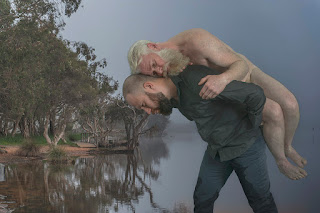 |
| Precinct 9 - 2018 © Christophe Canato |
Featuring work by Christophe Canato, Jennifer Cochrane, Mel Dare, Louise Dickmann, Jane Finlay, Indra Geidans, Paul Kaptein, Susan Roux, Vanessa Russ and Lynnette Voevodin. Guest Curator: Paola Anselmi.
Friday, November 30, 2018
Friday, November 23, 2018
Saturday, October 6, 2018
Article, Jean-Pierre Chambon. Périphériques N° 86. Revue culturelle d’information trimestrielle - Sept 2018.
Espace Vallès - 22 novembre, 22 décembre 2018
L’exposition Cet étrange objet du réel, détournant le titre illustre d’un film de Buñuel et lâchant l’obscur désir pour un étrange réel, rassemble sur les murs de l’Espace Vallès six artistes très différents : Christophe Canato, Manuel Dessort, Estelle Jourdain, Nadine Lahoz-Quilez, Johan Parent et Philippe Veyrunes. À travers la confrontation de leurs œuvres, les animateurs du centre d’art contemporain martinérois – Frédéric Guinot et Bertrand Bruatto – ont voulu susciter une sorte d’enquête. Ce n’est pas tant le réel de tout objet qui est ici interrogé que le sentiment d’étrangeté de chaque proposition et de ce que leur rapprochement provoque. Et c’est bien la définition possible de l’œuvre que vise, en filigrane, cette investigation : ce qu’on peut percevoir et comprendre de cet étrange objet du réel, ce qui en lui forme attirance. À chaque regardeur d’esquisser sa réponse, de décoder à sa manière le réel et ses objets exploratoires, de capter surtout l’étrange résonance qui en émane.
Les images produites par le photo- graphe et vidéaste Christophe Canato (il vit en Australie après avoir étudié à l’École d’art de Grenoble) sont empreintes d’une certaine dramatisation. Un obser- vateur avisé a caractérisé son travail et sa vision de « roman- tisme ironique », indiquant par-là la distance que l’artiste inscrit dans son penchant à l’expres- sion du sentiment. Prolongeant une série de photographies inti- tulée Ricochets, une vidéo donne à voir un rituel nocturne entre deux garçons affublés de masques d’animaux. Les gestes qu’ils esquissent en guise de langage codé, s’ils tiennent de l’imagi- naire du jeu d’enfants, suscitent une inquiétante étrangeté, tant le mystère de leur signi cation nous échappe. Extraite d’une autre série, une photographie de deux hommes prête à une lecture ambiguë sur le thème du double.
 |
| Galerie De Portraits 2018 © Christophe Canato |
Peintre et décorateur, Manuel Dessort (il a étudié à l’École d’art de Dijon puis Paris et vit dans la région grenobloise) mène en parallèle à son activité profes- sionnelle un travail de peinture et de dessin sur papier, tout en revendi- quant un lien naturel avec le chantier, son univers quotidien. Il considère que « tout support blanc immaculé est indécent et doit être investi ». Partant de ce principe catégorique, il « lâche tout » et, musique à fond dans l’atelier, révoquant l’ennui et armé de couleurs, il se jette « sur le vide papier que la blancheur défend », qui obnubila Mallarmé. Les in uences que Manuel Dessort énumère – Twombly, Basquiat, Van Gogh, Eugène Leroy, Richter et Debré – transparaissent dans l’énergie sauvage qui anime sa touche et la profusion de sa palette. L’organisation spatiale et rythmique de ses œuvres portent un écho des musiques écoutées au moment de leur réalisation.














